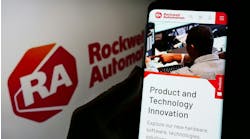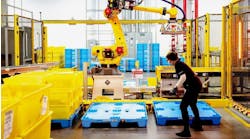Innovation, Recognition And Inspiration From The Ignition Community
Each year, the ICC event shines a spotlight on world-class Ignition projects in the Discover Gallery, which not only recognizes the sharp minds putting the software to work in the real world, but also serves as inspiration for future Ignition projects.
“I am constantly amazed by the incredible projects that our community builds with the Ignition platform,” said Steve Hechtman, Inductive Automation founder and CEO. “These projects validate the work that we do to facilitate greater innovation, and they inspire everyone who uses Ignition to push it even further.”
While nearly 20 projects were listed in the Discover Gallery, here find summaries of six that were celebrated as 2020 Firebrand Award-Winning Projects.
The Integration Group of Americas
WaterBridge, a midstream water-management company, was not receiving the level of reliability and support that it needed with its existing control and SCADA system. TIGA performed a phase-one engineering assessment to determine the level of effort required to replace WaterBridge’s control and SCADA systems to an updated IIoT platform. Through the assessment, TIGA was able to define a migration path to allow WaterBridge to gain flexibility, consistent visibility into its operations, ownership of its control and SCADA systems, and significant cost savings over the life of the systems. Ignition Edge with MQTT was implemented at 65 saltwater disposal facilities, and Ignition Perspective was used for mobile devices.
By leveraging Ignition, TIGA was able to deliver a system that WaterBridge needed in order to easily control operations. Allowing WaterBridge ownership of its control and SCADA systems has removed the need for the closed proprietary system. Operational processes are more efficient due to increased visibility for key stakeholders who can now make decisions in real time. Centralizing the data has helped not only operations but has also enabled a digital transformation. The collection of data is stored in one location and serves over 30 WaterBridge customers with the ability to monitor all aspects of the midstream allocation. (Find the full project description in the Discover Gallery here.)
Waste Management
Landfills and their systems require ongoing operations and maintenance support. This support can be required at any time of the day or night in all weather conditions, and can be costly to provide in terms of the physical cost to the employee and the monetary cost to the company.
Landfills contain many systems that are physically connected and dependent upon each other but are generally not connected together from a controls standpoint. These systems are spread out over hundreds of acres of land. Many of these systems must be monitored for environmental regulatory compliance. Like other systems, they also require maintenance and response to alarm conditions. Historically, much of the monitoring, response to alarms, and maintenance activities were performed manually.
Waste Management (WM) wanted to better serve the communities in which they operate, as well as the environment, while improving the quality of life for landfill employees. To do this, WM partnered with SCS Engineers’ Remote Monitoring & Controls division and Vertech to implement an Ignition 8.0 Perspective SCADA system at the WM landfill in West Edmonton, Alberta, Canada.
Through the vision of Waste Management Industrial Automation Group, the team implemented an Ignition 8.0 Perspective SCADA system with the goals of improving environmental protection, reducing operations and maintenance costs, and improving the quality of life for landfill employees. The Ignition system was built upon PLCs, and remote I/O units connected via a radio and cellular modem network. Two edge devices collect the majority of the data and send it to the main Ignition server via a cellular internet connection.
The new system was deployed at West Edmonton Landfill in Alberta, Canada. Since then, it has set the new standard for landfill SCADA systems within Waste Management. Before it was implemented, managers had little visibility into the day-to-day operations at the site, operators were unable to control equipment remotely, and direction of field operations and maintenance activities was time-consuming and difficult. Now managers have a live view of site activities, operators know when there are problems and can remotely act to resolve those problems, thus increasing efficiency.
The ability to monitor compliance obligations in near-real time provides staff with the capability to adjust to changing conditions on the ground within a long-range work capacity model. This model has shown significant value during challenging times and sets the tone for discussions on the future of landfill operations. (Find the full project description in the Discover Gallery here.)
Brock Solutions
As part of its Baggage 2025 program, the Greater Toronto Airports Authority (GTAA) had a vision to modernize their baggage-handling systems. The first step in this critical program was to replace the existing systems with a single upper level/SCADA system that would serve as the new heart of airport baggage operations.
The previous upper level/SCADAs were provided by a variety of vendors over the past 15 years using different, disconnected technologies (seven different independent SCADA systems, built on three different platforms). Each system had been built by different teams using different design principles. This made the software very hard (and expensive) to support, upgrade and maintain.
The new system installed by Brock Solutions was a combination of Ignition and SmartSort (Brock’s software for baggage sortation and reporting). SmartSort is a configurable baggage-sortation solution that allows the airport to meet its future expansion requirements. Ignition is the perfect platform to give the airport a true off-the-shelf solution for expansion in the future.
This project was an upper level/HMI replacement of the baggage-handling systems of both Terminals 1 and 3 at Toronto Pearson International Airport. This project went into live operation in March 2020.
As the Baggage 2025 program continues over the next five years, there will be many modifications and enhancements to the baggage-handling systems at the airport. The Ignition SCADA is now the firm foundation on which to build these efforts. The Brock Solutions and Inductive Automation partnership will be instrumental in allowing the GTAA to realize its vision and goals as it seeks to build upon its world-class airport. (Find the full project description in the Discover Gallery here.)
Flexware Innovation
At Veoneer’s facility in Goleta, California, the company manufactures advanced night-vision systems for the world’s leading automakers. For supervisory control and traceability, Veoneer used an internally built system in Goleta. Due to a change in the corporation’s structure, this solution was no longer viable and Flexware was asked to develop a solution that replaced and enhanced the previous solution’s functionality with the Ignition platform. Prior to this engagement, Flexware developed a custom MES solution for a different Veoneer facility with the Ignition platform, and word traveled around the organization about how powerful the software is. It was an easy decision to continue the use of Ignition at the Goleta facility.
Flexware began by leveraging its internal MES framework, which was built up through various MES solutions developed in the past. This framework includes a database schema, configuration application, and many workstation applications that handle most of the features required in a typical MES solution.
However, the framework had not previously been leveraged for low-level SCADA operations. At Veoneer’s Goleta facility, the previous solution was very tightly coupled with the automation layer and was essential for the line to operate. To add this functionality, Flexware added another layer to its existing traceability architecture, which included products, product routes, product operations, order routes, order operations, and order operation attributes. This layer is called action scripting—routes under the hood allow Flexware to define low-level PLC interface data transfers and validations inside of its configuration application. Flexware also added a new operation type, HTTP operation, which interacted with line-side PC stations using HTTP GET and POST methods via the Web Development Module.
Flexware developed a complete MES framework from scratch using out-of-the-box Ignition tools. This repeatable framework handles product traceability, inventory management and production-run management in addition to other offshoots for production. At the core of the framework, Flexware focused development attention to build a completely configurable solution that Veoneer can administer entirely from the client without backend modifications.
In just three months, Flexware was able to redevelop a system that was built over many years by a large team. The system is now fully implemented and much faster than the previous system.
The biggest improvements the solution provides over the previous system for Veoneer are configurability and data analysis. Leveraging Flexware’s newly developed Action Scripts, Veoneer can create and customize actions all from the configuration application, which allows it to be much more adaptive in the future. (Find the full project description in the Discover Gallery here.)
Controtek Solutions
This project for Manila Water Company integrates remote local control systems of water-supply and used-water facilities, in different locations, into a centralized SCADA system for remote data gathering, operations monitoring, and enterprise integration. Ignition is connected to 93 sites.
There was no centralized monitoring for status and plant performance on remote locations. Manual calculations were needed for operations analysis and reporting.
The solution was to automate the process of data collection with a centralized Ignition SCADA system. Online access to data is provided via desktops, laptops, tablets, and mobile phones. Controtek also created a tool for operations data and alarm monitoring, and reporting.
The system now has one absolute data repository. It also includes comprehensive dashboards and detailed maps. With Ignition’s modules for reports, alarm notification, visualization and history, Controtek was able to meet Manila Water Company’s requirements and exceed its expectations. With Ignition, Controtek is able to provide high-quality interfaces that are custom-tailored to the needs or preferences of specific customers.
Manila Water is now able to showcase its new SCADA system, not just because of the functions and accuracy of data and calculations, but also because of standardized user interfaces and dashboards that fit the latest trends in visual presentation.
Manual intervention on calculations has also improved. Monitoring of plant status and reports are simplified and easily accessible. Also, there is no need for daily reminders of sending reports to plant managers because of the scheduled sending of reports and automatic sending of critical alarm data via email.
With Ignition’s scalable modular architecture and the map module created by Kymera Systems, Controtek incorporated an additional feature that displays map views with pins that represent each station’s status and operations. Users can quickly drill down for more data. (Find the full project description in the Discover Gallery here.)
Vertech
The goal was to provide an ISA-88 batch control solution for a greenfield site for can/bottle beverage production at an AriZona Beverages plant in Keasbey, New Jersey. Team leaders also wanted to provide MES/SCADA functionality for OEE, downtime tracking, detailed production scheduling, and SAP/MES interfacing for process orders, batch, and finished goods reporting.
Vertech was brought into this project to provide a world-class automation solution. The client requested the Ignition platform to be used for all MES, batch and process control functions for batching syrup concentrate and tracking production from raw materials through finished packaged goods.
For syrup concentrate batching, a process-engineering firm designed a production process which was extremely flexible, allowing AriZona to produce any of its beverage products in its portfolio using a combination of three manual addition premix batch stations and 12 syrup batch tanks. In order to accommodate the process design, an ISA-88-inspired batch control system had to be created with Ignition. The batch control system allows the client to create flexible batch recipes at runtime, which allows parallel phase control, sequential phase control, or any combination. The batch control system allows the batch recipe to be scaled to the needs of production and minimizes batch times by automatically controlling bulk additions of raw materials while operators perform manual additions.
AriZona also requested that the process control system and MES interface with its ERP system (SAP) to exchange real-time production and business traceability. The batch control system would become a critical link for both production control and business system tracking. While the Ignition platform and Sepasoft MES modules provide the means of creating much of the functionality requested by AriZona, an industrial batching solution would need to be custom-built by Vertech.
The batch control system follows ISA-88 models and terminology. A physical model was created to define Units, Equipment Modules and Control Modules while a process model was created to identify Phases, Operations and Unit Procedures. The batch control system was then designed to allow the end user to build a batch recipe based on the objects and constraints defined within those models.
The batch control system directly interfaces with Rockwell Automation’s PhaseManager feature, which provides ISA-88-compliant PLC code within the Studio 5000 Logix Designer programming software. By utilizing PhaseManager, the design of the custom batch control system would require Ignition to interface with the PLC in the same fashion as competing ISA-88-compliant control software packages do. By leveraging PhaseManager and adopting the models and terminology of ISA-88, Vertech ensured that the custom batch control captures the overall spirit of industrial batching.
With the creation of the batch control system, Vertech was able to provide the client a world-class solution which interacts with every level of the automation, from device control to ERP.
The Sepasoft MES Web Services Module was used for SAP/MES interfacing, and the Sepasoft OEE 2.0 Module provided functionality for scheduling of batching and packaging work orders, as well the primary means of tracking OEE and downtime of the five packaging lines and 12 batch tanks. Batch control allows operations to produce the required product.
Six distinct Ignition projects were created:
● MES Management Application—Batch recipe management, MES/SAP interfacing, production scheduling, production/downtime history and analysis, batch and CIP reports, batch/packaging finished goods yields, system security and configuration.
● Plant-Floor Batch Control—Traditional plant-floor SCADA application for all batch operations and process control functions. Provides access to batch phase control, device control for valves, motors, analog inputs/outputs, digital inputs/outputs, CIP control, and overall process equipment status. Provides OEE/Downtime tracking and entry at each packaging line.
● Perspective Application—Provides read-only information on raw material inventory, syrup batch tank inventory, and packaging-line OEE.
● Plant Dashboards—Production dashboards for display on televisions throughout the plant.
● Data Collection—Backend application for data collection and transaction groups.
● MES Gateway Application—Required for Sepasoft Modules.
As a result of the custom batch solution and multiple Ignition projects, AriZona has complete visibility of its business and production process through Ignition and Sepasoft MES. Vertech created a closed-loop production process and business data process within a single platform, allowing this greenfield site to produce a higher-quality, more consistent product quicker, easier, and cheaper than traditional methods would have allowed. (Find the full project description in the Discover Gallery here.)




